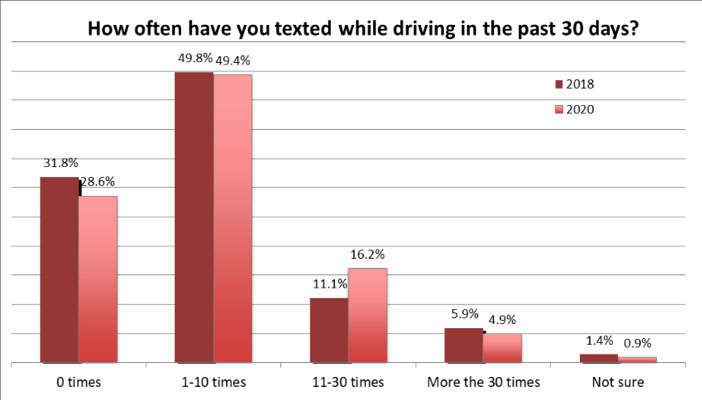
VOLUME 6, ISSUE 1
MENU

Texting and Driving in Texas:
What Texans Think
According to the Texas Department of Transportation, one in five crashes in Texas each year result from distracted driving. Even though texting while driving is only one type of distracted driving, it causes reaction time to double, and those drivers have a harder time staying in their lane and maintaining a consistent speed. While many Texans may think texting and driving is bad, is it enough to force them to change their own habits behind the wheel?
In 2017, Texas instituted a statewide legislative ban on texting while driving. This ban occurred after similar unsuccessful attempts, including the last one vetoed by the governor. In the absence of statewide law, many local jurisdictions had already passed their own form of the ban. These ordinances ranged from not only prohibiting texting but also handheld cell phone use while driving, with a variety of stipulations ranging from a complete ban on use to restrictions specific to location, driver and purpose.
The statewide ban on texting preempted local ordinances related to texting and required cities to post signage at entry points for standing ordinances that add restrictions beyond the state texting ban. This situation confused many citizens and continued as certain exceptions such as allowing texting while stopped and for purposes such as using map applications were also added.
To better understand how the ban was perceived, researchers from the Texas A&M Transportation Institute’s (TTI’s) Center for Transportation Safety conducted a Traffic Safety Monitor poll in August 2018. The poll was conducted with more than 600 Texas respondents and aimed to assess awareness of the new law, perceptions of enforcement, attitudes toward texting and driving, and self-reported behavior changes.
The survey found a third of respondents reported decreasing cell phone use while driving; 68 percent had texted while driving at least once during the previous 30-day period. Respondents generally favored the law and keeping it but perceived lack of enforcement. There was also lack of awareness of the law’s applicability in local areas and the amount of the fine associated with violations.
Two years later, the same Traffic Safety Monitor poll was used to measure changes and document current self-reported behavior and beliefs on texting and driving.
“We can never have enough information leading to a better understanding of human behavior with respect to traffic safety” says principal investigator Katie Womack, TTI senior research scientist. “This survey was a follow-up to one conducted soon after the texting and driving ban was enacted in Texas. After two years of experience under the prohibition, we wanted to see if behaviors or beliefs had changed.”
The 28-question survey of 576 Texans was conducted online August 21–25, 2020. Researchers initially analyzed poll data against the responses obtained in 2018. The results indicate drivers are texting more now than a year ago, according to self-reports of texting behavior. Drivers are no more aware of the texting ban now than they were in 2018. For those who are aware, a higher percentage perceive the law as strongly enforced, and there is more firsthand knowledge of enforcement activity. In general, Texas drivers regard the texting ban less favorably than in 2018.
“Tracking shifts in behavior in relation to legislation, enforcement, and education is important for gauging impacts and influencing future efforts” says Womack. “Surveys of this type are helpful tools, especially for measuring change over time. Examining behaviors and beliefs among various driver subgroups gives direction to programs and actions aimed at making further improvements.”

Self-reported texting and driving habits in 2018 vs. 2020

In 2017, Texas instituted a statewide legislative ban on texting while driving.

“After the law took effect, 68 percent of drivers said they had texted while driving within the previous 30 days. Though they acknowledge the danger, many drivers nonetheless seem to think they can manage the dual tasks safely.”
TTI Senior Research Scientist